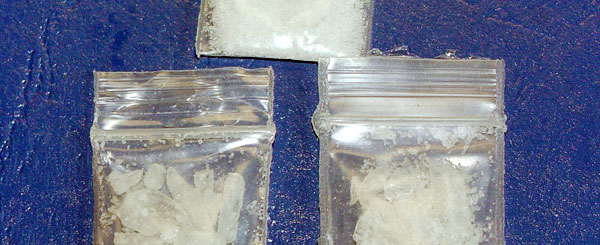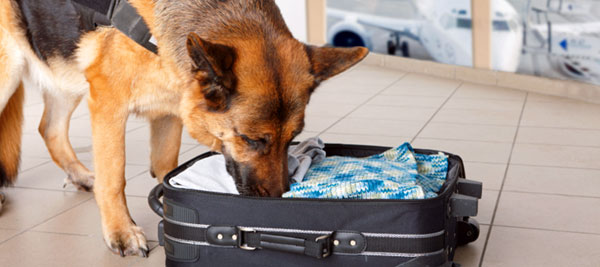How It’s Done
Evidence That May be Collected
Evidence collected during an investigation involving illegal drugs can include the substance itself, containers used to transport the substance, utensils used to manufacture or use the substance, or in the case of manufacturing, the component chemicals used to create an illegal substance. Drugs can take the form of pills, powders, liquids, plant material such as leaves and mushrooms, crystalline materials (crystal methamphetamine), and cases such as MDMA or ecstasy, can be imbedded in paper or foods like candy.

Crystal methamphetamine. (Courtesy of NFSTC.)
At crime scenes where illegal substances are suspected to have played a role, the substances in question could be residue on other items or liquids that have soaked into fabrics. In these situations, the evidence collected could be anything within the crime scene including biological samples, most commonly blood or urine, from victims and suspects.
In cases of drug smuggling, illegal drugs can be transported in small amounts through luggage or on an individual, hidden in innocuous places such as cosmetic bags or medicine bottles. Often drugs are smuggled inside the body using plastic bags or other small soft containers that fit into cavities or can be swallowed and regurgitated. However, drugs smuggled in large volumes may come through cargo shipments of other goods such as canned or boxed food items, prepackaged consumer goods, garments or fabrics, and hollow items such as ceramics or tubing. There are an unlimited number of channels for smuggling drugs into the country and evidence could include anything from personal handbags to entire shipping containers and their contents as part of these cases.
For example, in December 2012, Customs officials at the Miami International Airport found 231 pounds of cocaine worth approximately $2.7 million dollars in three suitcases arrived from Ecuador. In a larger smuggling case from 2008, Australian authorities seized 4.4 tons of MDMA worth more than $300 million. The pills were being smuggled inside tomato cans imported from Italy. 4

Dogs trained to detect the presence of illegal drugs are often used at locations that could be used to smuggle drugs into or out of the country such as airports or train stations.
How the Evidence Is Collected
Drug evidence is collected using the same evidence collection methods used for other types of crimes. Evidence is collected, photographed, packaged, documented and sent for analysis using the guidelines and processes in place at the responding agency. Packaging of the drug is based on the type of material present. For example, plant material should not be packaged in plastic due to the moisture content and tendency to grow mold. If investigators collect a syringe or other sharp object, those are packaged in hard-sided packaging such as cardboard cartons or glass vials and labeled as a potential biohazard. Any biological samples collected would be packaged according to proper evidence handling procedures. Learn more about evidence collection and crime scene investigation ▸
In the case of drug manufacturing or clandestine laboratories, investigators may be faced with hazardous conditions. Many of the chemicals used to manufacture illegal drugs are toxic or volatile and must be packaged in small amounts using specialized containers to protect the safety of laboratory staff package handlers. Most agencies have strict guidelines for the processing of clandestine laboratories and packaging of collected materials.
Who Conducts the Analysis
Law enforcement officers or other investigators in the field may employ presumptive colorimetric test kits or handheld instruments to analyze samples. This form of analysis is presumptive only and helps the investigator determine if a substance could be illegal and take appropriate action. Agencies that may conduct presumptive testing include police, border patrol, customs, corrections, National Park Service rangers, homeland security personnel and federal agents. Whether or not a presumptive test is conducted, the collected material will be submitted to a forensic laboratory for confirmative testing.
According to the 2009 Census of Publicly Funded Crime Laboratories, an estimated 1,356,000 requests for analysis of potential controlled substances were made to crime labs in the U.S. That equates to 33 percent of all requests made to these labs and is second only to DNA testing requests.
Once a sample reaches the laboratory, it will be subjected to a battery of tests by a trained forensic chemist who specializes in drug chemistry. Forensic chemists must meet specific educational and training requirements in order to handle evidence, and every agency or jurisdiction has different criteria for meeting these requirements. The Scientific Working Group for the Analysis of Seized Drugs (SWGDRUG) publishes recommendations for minimum levels of education, training and continuing education for analysts.
How and Where the Analysis is Performed
Collected evidence is sent to a forensic laboratory where a trained forensic drug chemist will perform several series, or batteries of tests and complete an analysis report that can be used in court proceedings. Each laboratory has specific procedures for analyzing evidence including the number of presumptive and confirmatory tests performed. In general the analysis includes:
1. Weight test determines the net weight of the material. Evidence submitted can range from residue on a surface to stains on fabric to pounds or tons of seized material. Analysts use analytical balances to weigh the material and record the results for the analysis report. The weight test will also determine if the quantity of material is sufficient for further testing.
2. Presumptive testing or screening determines the general characteristics of the sample material and allows analysts to narrow down the field of confirmatory tests that will be used. Presumptive laboratory tests may include:
- Microscopic analysis looks at the structure of the material to make a preliminary estimate as to what it may be. This test is most suitable to plant material.
- Microcrystalline test involves dissolving a small amount of the sample in a solution and letting the material form crystals. Substances will crystallize in a specific manner allowing analysts to identify components of a sample by viewing the crystals under polarized light.
- Ultraviolet spectroscopy works by exposing the material to UV light and measuring the way the material absorbs the light. Different chemicals absorb light differently and can give clues to analysts about what might be present in the material.
- Gas chromatography may provide presumptive identification of materials, but is commonly used to separate components prior to confirmatory testing.
3. Confirmatory testing includes separation and identification of the individual components of the material. Confirmatory testing is usually a two-step process by which the analyst first separates the compounds using a suitable method such as gas chromatography (GC), capillary electrophoresis, or wet chemistry. Once the components are separated, instruments such as a mass spectrometer (MS) or infrared spectrometer (IR) are used to identify each component by comparing its chemical signature against reference materials.
These processes may be combined depending on laboratory policies. The most common is gas chromatography/mass spectroscopy (GC/MS); however gas chromatography can also be combined with infrared spectroscopy (GC/IR) among others. The most common techniques used to separate the compounds in a sample include:
- Gas chromatography - an instrument that separates substances into individual components by dissolving the material in a liquid solvent, injecting the liquid into a superheated oven, vaporizing the liquid and pushing it through a very small, very long, glass capillary tube using a carrier gas such as helium or hydrogen. The mixture separates into individual chemical components inside the tube. As each component travels through the tube at a slightly different speed, the analyst can measure the time it takes each component to emerge and compare that to reference materials.
- Liquid chromatography - is similar to gas chromatography, however the evaporation phase using the superheated oven is removed. The material is dissolved into a liquid and injected into a wider, shorter stainless steel capillary tube at a high pressure. The components will then separate inside the tube and emerge at different times. This method is used when the material may be sensitive to the high temperatures required in gas chromatography.
- Capillary electrophoresis - uses an electrical field to separate the components inside a capillary tube. Molecules move toward the positive or negative charges placed at either end of the tube and analysis can measure the speed and direction at which they move to compare against reference materials.
- Wet chemistry - involves the use of liquid solvents to separate compounds.
Instruments most often used to identify compounds include:
- Mass spectrometry - once the components of a material are separated, mass spectrometry uses a beam of electrons that causes them to break apart. Chemicals always break apart in the same way due to their chemical structure and this can be mapped into a spectrum and compared against a database of known spectra.
- Infrared spectroscopy - uses infrared (IR) light to decipher the chemical signature of materials, specifically the bonds between atoms. Different components in a sample will absorb IR radiation differently and analysts can use this information to compare against reference materials.
4 “$2.7M of Cocaine Seized from Suitcases at MIA,” CBS Miami online, (2012) accessed 8/20/2013.